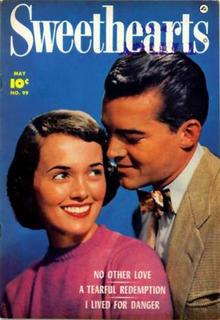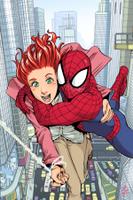 I made a vow to myself that I wanted this blog to be about romance comics, only romance comics, and not let the real world or my own life get in the way. And while I was the only one to know about this vow, please allow me to break it and talk a bit about what's been happening in the world (specifically the Gulf area of the U.S.) these last few days and try and have it relate to comics.
I made a vow to myself that I wanted this blog to be about romance comics, only romance comics, and not let the real world or my own life get in the way. And while I was the only one to know about this vow, please allow me to break it and talk a bit about what's been happening in the world (specifically the Gulf area of the U.S.) these last few days and try and have it relate to comics.In September of 1999, I was living in a first-floor apartment in Manville, New Jersey, a town known mostly for its asbestos factory and the numerous deaths and lawsuits that came from it. My apartment looked out onto a park and the small river (a stream, really), the Raritan, that ran through it. It wasn't a great view, by any means, and not a great apartment.
But it didn't much matter because Hurricane Floyd came through on the 16th of that month, dumping inches of rain on the region, saturating the ground. That night, as the hurricane passed, high tide pushed millions of gallons of water from the Atlantic back into the Raritan, making what was just a lot of water into an immense flood. By midnight my apartment had 5 feet of water in it. Half of Manville was submerged. The neighboring town of Bound Brook had it even worse.
Other than my cats, my roommate's computer, and a few boxes of my most valuable comics, I lost everything.
I realize that my plight, as devestating to me as it was (and it was quite devestating), seems to pale in comparison with what's happening in the wake of Katrina, but this week has brought back a lot of really bad images and memories, much of which I'd like to never have to think of again. And while those in Louisiana and Mississippi who lost their lives or whose family members perished have pain worse than I could ever feel, I still feel a great sense of personal empathy with them.
I know what it was like. I saw and felt the muddy, cold water. I did unrealistic things thinking I could save my things, putting myself in harm's way.
The comics I tend to collect, the old ones at least, are for me to read and are not for investment. I don't really mind if they have tears or pieces missing or tape, just as long as they're complete and readable. I don't have the money (nor the urge) to buy pristine copies of things when I could use the same amount of money to buy 20 different copies of comics in lesser condition (I don't begrudge those who look for condition, however, as we all have our peculiarities).
But since 1999, I won't buy a comic with water damage. I won't buy a book with a water stain. If an album sleeve has water-related problems, I'll put it back. When you walk into your apartment and see your things completely water logged, dozens of boxes of comics, numerous bookshelves full of books, hundreds of CDs and records, all which had been under water for 24 hours, you tend to want to avoid that sort of thing, even if the damage is miniscule in comparison.
It also bothered me very much that many of the comics that were destroyed in my flood (I'm very possessive about it) I had had in my collection for 20 years. They were mine. They never had another owner, and if they had survived, they likely wouldn't have had one for many decades to come. They all had a personal history.
That's why when now if I see two copies of the same old comic, same price, same condition, if one has a name written on the cover, I'll take that one. Because some kid (or teen or adult) bought it (or traded for it or had it passed down from an older sibling) and thought enough of it to write their name on it. It's mine. Forever. (And for a kid, forever really isn't that long at all.)
I never wrote my name on my comics (and I never have), and I don't even write my name on the inside of my books (as some people do), but it doesn't bother me at all when I buy a used book or comic that someone had done that to.
It's history.
I feel terrible that the people in the Gulf have lost their personal history, at least their material history. I know it's how I felt when I lost my own.
If you have the means and the urge, please donate to the Red Cross or Operation U.S.A.


















